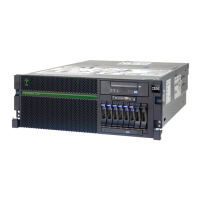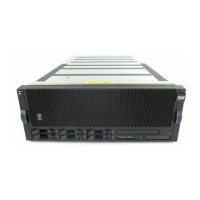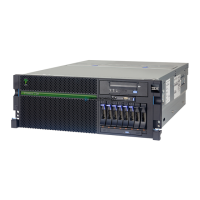Chapter 3. Virtualization 123
Later, dynamic logical partitioning increased the flexibility, allowing selected system
resources, such as processors, memory, and I/O components, to be added and deleted from
logical partitions while they are executing. AIX Version 5.2, with all the necessary
enhancements to enable dynamic LPAR, was introduced in 2002. At the same time, Red Hat
Enterprise Linux 5 and SUSE Linux Enterprise 9.0 were also able do support dynamic logical
partitioning. The ability to reconfigure dynamic LPARs encourages system administrators to
dynamically redefine all available system resources to reach the optimum capacity for each
defined dynamic LPAR.
Micro-Partitioning
The IBM Micro-Partitioning technology allows you to allocate fractions of processors to a
logical partition. This technology was introduced with POWER5 processor-based systems. A
logical partition using fractions of processors is also known as a
shared processor partition or
micro-partition. Micropartitions run over a set of processors called a
shared processor pool,
and virtual processors are used to let the operating system manage the fractions of
processing power assigned to the logical partition. From an operating system perspective, a
virtual processor cannot be distinguished from a physical processor, unless the operating
system has been enhanced to be made aware of the difference. Physical processors are
abstracted into virtual processors that are available to partitions. The meaning of the term
physical processor in this section is a processor core. For example, a 2-core server has two
physical processors.
When defining a shared processor partition, several options must be defined:
The minimum, desired, and maximum processing units
Processing units are defined as processing power, or the fraction of time that the partition
is dispatched on physical processors. Processing units define the capacity entitlement of
the partition.
The shared processor pool
Select one from the list with the names of each configured shared processor pool. This list
also displays the pool ID of each configured shared processor pool in parentheses. If the
name of the desired shared processor pool is not available here, you must first configure
the desired shared processor pool using the shared processor pool Management window.
Shared processor partitions use the default shared processor pool, called DefaultPool by
default. See 3.4.3, “Multiple shared processor pools” on page 126, for details about
multiple shared processor pools.
Whether the partition will be able to access extra processing power to use its virtual
processors above its capacity entitlement (selecting either to cap or uncap your partition)
If spare processing power is available in the shared processor pool or other partitions are
not using their entitlement, an uncapped partition can use additional processing units if its
entitlement is not enough to satisfy its application processing demand.
The weight (preference) in the case of an uncapped partition
The minimum, desired, and maximum number of virtual processors
The POWER Hypervisor calculates partition processing power based on minimum, desired,
and maximum values, processing mode, and is also based on requirements of other active
partitions. The actual entitlement is never smaller than the processing unit’s desired value, but
can exceed that value in the case of an uncapped partition and up to the number of virtual
processors allocated.

